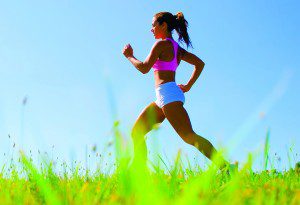

It’s the coolest, most serene part of the day, and there’s nothing like a morning run to boost your mood all day long.
2. Drink Like Crazy
Even if you don’t feel thirsty, drink at least 8 oz. of fluid each hour, and more if you’re outside or tend to perspire a lot. You’ll run better with adequate fluid intake, and you’ll feel better, too. By keeping your water storage high, you’ll also improve your body’s cooling mechanisms.
3. Acclimate With Care
You need to acclimate to the heat in a safe and gradual manner, not haphazardly. For the first two weeks of hot weather, do no speed sessions and keep your midday running bouts to 30 easy minutes at most. (You can go longer on cool mornings or evenings.) In 10 days to two weeks, you should be fully acclimated.
4. Go Light and Loose
Wear light-colored, loose-fitting clothing. The former will reflect the sun’s rays better; the latter will enable you to take advantage of any breeze, including the one you make by running. The new sports-specific synthetics are better than cotton, too. They stay drier and wick moisture better than natural fibers do.
5. Screen it Out
To protect yourself from skin cancer and other skin damage, use sunscreen liberally. Do so even on partly cloudy days; harmful ultraviolet rays are not blocked by cloud cover. Another benefit: Sunscreen can decrease your skin and body temperatures, so you’ll stay cooler during exercise.
6. Maximize Head Room
You lose a major portion of body heat through your head, which is bad in winter but good in summer. So on hot days, don’t cover your noggin tightly with a hat. Cover it, for sure, but with a loose-fitting hat, preferably made of mesh or some other breathable material.
7. Start Slowly
Starting your run slowly is particularly beneficial on hot days. The slower you start, the longer you’ll keep your body heat from reaching the misery threshold. If you normally run at an eight-minute mile pace, for example, do your first mile at a 10-minute pace.
8. Head for Water
Running near water—whether it’s along a river, lake or ocean—is usually cooler and breezier. Urban streams often have paths running alongside of them, if you take the time to explore. And even if the air temperature is about the same, you’ll likely feel cooler just being near water.
9. End With a Dunk
There is absolutely no better place to start a run than at a pool. Why? Because when you finish your run there, you can take a refreshing dip. Once a week or so this summer, bring your bathing suit and running gear to the pool.
10. Run Fountain-to-Fountain
As a fallback for those beastly hot days, design a run that takes in frequent water stops. Water fountains are the obvious choices, but there are many more possibilities. When you map out your route, consider gas stations, health clubs, hospitals, schools, convenience stores and city parks.
11. Make Like a Camel
Especially on long runs or trail runs where you’ll be away from water sources, bring your own. Use a water belt, pouch or holster for bottles or simply carry it (you’ll get used to it). Another option: The night before your long Sunday run, take your bike or car out and stash several bottles along your next day’s running route.
12. Heed the Heat Warnings
You need to be very sensitive to the warning signs of heat illness, which, if it progresses, can be fatal. If you feel trouble coming on, you need to stop running, find some shade, get liquids and then find a ride or walk home. Following are signs of impending heat illness:
• Headache or intense heat buildup in the head.
• Confusion or lack of concentration.
• Loss of muscular control.
• Oversweating followed by clammy skin and
cessation of sweating.
• Hot and cold flashes.
• Upset stomach, muscle cramps, vomiting,
dizziness.
13. Decrease the Speed
Do your speed training in the morning or evening. Otherwise, you’re really going to put a strain on your system. The heart literally beats faster in high heat, as it’s pumping extra blood out to the skin as part of the body’s evaporation/cooling mechanism. You won’t be able to run as fast, so don’t try to.
14. Lower Your Expectations
In training and in races, you won’t be able to run as fast as you would on cool days. If race day comes, and it’s super hot that morning, ease back and treat it as a training run — and drink at all the water stops.
15. Watch What You Drink
Both caffeine and alcohol are diuretics, which means they increase urine output. This puts you at greater risk of dehydration. Since hot weather is already causing you to dehydrate faster, be especially careful about your caffeine and alcohol intake in summer. Be careful if you drink a lot of iced tea, as it contains a significant amount of caffeine. An alternative: herbal iced tea.
16. Bag It if It’s too Hot
Some days are going to be unsafe for running, especially if you live in an urban area where air pollution is also a concern. On those occasions, consider skipping running.
Sure, it’s going to be hot this summer. No way around that. But with some planning and a little imagination, you can minimize the downside and make it work for you. Stay flexible, have fun and, above all, be safe.
Source: active.com
 Southwest Florida's Health and Wellness Magazine Health and Wellness Articles
Southwest Florida's Health and Wellness Magazine Health and Wellness Articles

